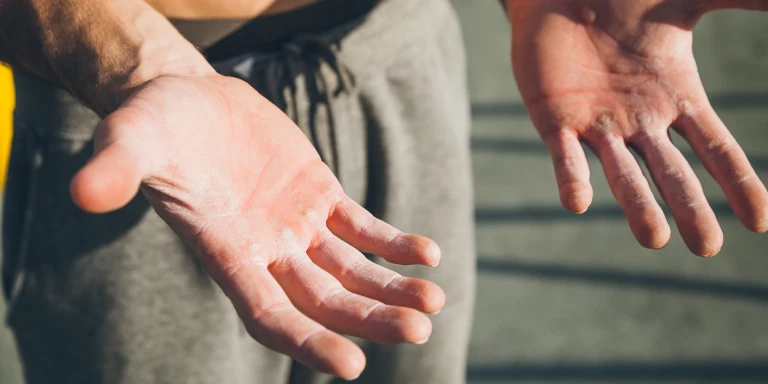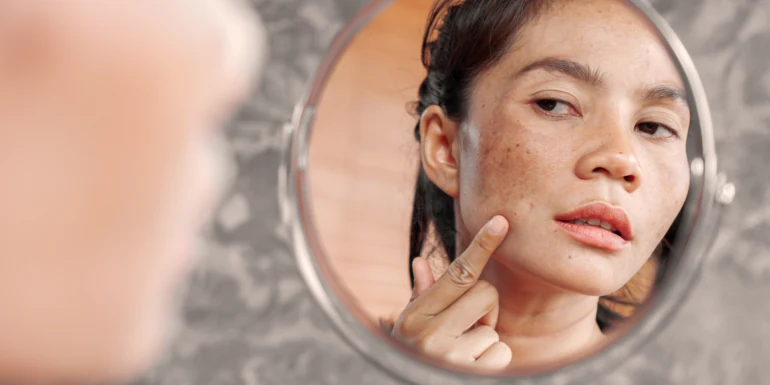
Getting rid of calluses – tips for combatting calluses
During the summer, when we walk around barefoot more often, we often get rough patches on our feet. What causes calluses? And how can you get rid of them? Discover effective home remedies for calluses and what you can do if callused skin is painful.
A callus is a thickened, dried bit of skin. Calluses usually occur on your heel, but you can get them on other parts of your body.
What causes calluses?
Why do we get calluses? Calluses usually occur when pressure and friction is applied to the skin, such as when you wear shoes that are too tight. While your feet are usually prone to calluses, you can also get them on your hands, fingers, elbows and other parts of your body.
Dryness promotes the occurrence of calluses. When pressure, friction and dry skin come together, the outer layer of skin (the epidermis) reacts with what is known as “hyperkeratosis”, which is the medical term for the increased build-up of calluses. The skin creates corneocytes, which are dead cells from the outer layer of skin that are mostly made up of the protein keratin and are shed by the epidermis.
What is the function of calluses?
Calluses are much tougher and thicker than regular skin. This means that they protect the skin, on your foot or hands for example, from blisters and other abrasions. Having some calluses is completely normal and healthy. If you have healthy foot alignment, calluses will mainly occur on your heels and on the balls of your feet. However, if you spot that you have calluses on the joints of your toes or on the outside of your foot, this can be a sign of an issue with the alignment of your foot and you should have this looked at by your doctor.
Why do my calluses hurt sometimes?
It may be that your calluses hurt when you are walking. This happens when increased pressure or very dry skin causes cracks – known as rhagades – to form on the callus. Germs can get into these cracks, which can then lead to pain and inflammation. For this reason, it is important to make sure that calluses do not become too dry and you regularly apply cream the dry skin.
Preventing calluses
We can often find calluses to be aesthetically displeasing. Although you may want to prevent calluses, remember that they have a protective function. To prevent the excessive occurrence of calluses on your feet, you should:
- Wear comfortable shoes – tight shoes can create pressure points that can cause calluses
- Walk barefoot as often as possible
- Avoid high heels – they increase the pressure on calluses
- Care for your feet on a regular basis: bathe your feet in a lukewarm footbath and then apply a thick cream to your feet
Whether you are seeking advice on diet and exercise, coping with a diagnosis or a recommended treatment, we will give you expert and individual answers. Our health consultation advisors will provide you with helpful information and practical tips.
Treating calluses
In the summer in particular, shops are often filled with products that claim to efficiently get rid of calluses. But if you already have cracks on a callus, you should be careful not to cause more damage to the skin. While sharp callus shavers or “anti-callus” socks cause calluses to come off over a large area, they do also irritate the skin. Anti-callus socks contain active agents that can trigger allergic reactions if you have sensitive skin. Thick and moisturising creams are a proven treatment, and work best when applied to the callus twice a day. Some creams also contain urea, which is particularly effective against dry skin. Take care when using creams containing salicylic acid as this can cause a burning sensation or make it itchy, thus further irritating the skin.
Removing calluses with care tools
It is also possible to remove calluses by “mechanical” means. To avoid inflammation, you should make sure that you always clean care tools thoroughly after use.
Pumice stone
A pumice stone is a great way of treating your feet to regular exfoliation. Best used after a shower, bath or foot bath, move the stone in circular movements over the callused skin – but take care not to rub too hard.
Callus file
A callus file is a good alternative to a pumice stone, and many people find them easier to use. Be sure to use the file on dry skin rather than on wet skin.
Callus scraper
Callus scrapers and callus planes should be used with care. You should have a podiatrist use a callus plane on your calluses as there is a significant risk of injury.
Electric callus remover
Electric callus removers are very effective. The important thing is to make sure that you do not apply too much pressure and that you avoid using the device on the same spot for too long as this can harm the skin.
Removing calluses with home remedies
There are also many ways of removing calluses that are kinder to your skin:
Baking powder
Treat your feet to a foot bath with a packet of baking powder. Bathe your feet for at least 10 to 15 minutes and then gently file down the softened calluses.
Vinegar
Vinegar works in a similar way to baking powder, so instead of baking powder you can put a dash of vinegar in your foot bath and then remove your calluses using a pumice stone, for example.
Lemon juice
Fresh lemon juice is another very popular method of removing calluses because the citric acid softens the rough skin. Half a lemon and place one of the halves on the treatment area, then hold it in place with a sock and leave to work for 30 minutes.
Coconut oil
Coconut oil is a popular method of treating calluses on feet, hands and elbows as the rich oil is particularly effective against dry skin.
Health before beauty – this also applies to calluses. We place great importance on having well-groomed and smooth feet – especially in the summer – but we should not forget that calluses are there to protect our skin. So, if you want to remove calluses from a certain part of your body, you should make sure that you choose a gentle method for doing this.

The expert provided the editorial team with advice and input for this article. Julia Pieh (doctorate in pharmacy and toxicology, pharmacist, naturopath) works in the Helsana Health Consultation Service.


Newsletter
Find out more about current health issues every month and get all the information you need about our attractive offers from all Helsana Group companies * delivered by e-mail to read whenever it suits you. Our newsletter is free of charge and you can sign up here:
We did not receive your information. Please try again later.
* The Helsana Group comprises Helsana Insurance Company Ltd, Helsana Supplementary Insurances Ltd and Helsana Accidents Ltd.